It’s simple, affordable and deeply unglamorous – and yet, as someone who has spent their career studying the effects of diet on health, I believe fibre may be the most under-appreciated nutrient of all.
Until recently, the only place you’d hear it mentioned was in adverts for unfashionable slimming clubs or printed on the back of a cereal box.
But today fibre is enjoying a well-deserved renaissance since its 1980s heyday – thanks, in part, to a viral social media trend.
Unlike so many internet fads, though, this one is firmly grounded in science. A form of carbohydrate, fibre is found naturally in plants, from fruits and vegetables to legumes, nuts, seeds, and wholegrains like oats and spelt.
And it plays a vital role in keeping the digestive system running smoothly.
It supports the gut microbiome – the community of bacteria and other microbes that live in our intestines and are vital for health – and helps food pass efficiently through the body.
There’s now a wealth of evidence showing that getting enough fibre can transform your health – helping to stabilise blood sugar, reduce inflammation and improve everything from digestion and weight to mood and skin.
Some studies even suggest it plays a role in lowering the risk of serious diseases such as heart disease, stroke, type 2 diabetes and certain cancers.

Fibre-rich foods, explains Dr Federica Amati, are packed with essential vitamins and minerals and help keep you full while containing fewer calories than other foods
Recently crowned ‘nature’s Ozempic’, fibre acts on the same hunger-regulating pathways in the brain as GLP-1 drugs, switching off appetite and curbing cravings – without the potential downsides.
Enter ‘fibremaxxing’ – a TikTok trend that’s putting this nutritional workhorse back in the spotlight. Videos tagged with the term have racked up millions of views, with influencers – myself included – showing off their fibre-packed meals and sharing daily targets.
In the comments, users compare notes, post before-and-after photos and rave about their results. Some say it has helped them finally lose stubborn weight. Others credit it with better digestion, more energy and clearer skin.
And the best part? You don’t need fancy powders or supplements to get started – chances are, the key ingredients are already in your kitchen cupboard.
Anyone who knows about nutrition will be well aware of all this and, no doubt, will have despaired at the rise of restrictive, low-carb diets such as keto and paleo, which shun veg, fruit and wholegrains. Along with the recent obsession with consuming vast amounts of protein, it meant fibre has been quietly elbowed off the plate.
This is a huge error. Adults should be eating about 30g of fibre a day – but fewer than one in ten of us hit this target.
This is all the more disturbing when you consider that low fibre intake is a factor in nearly a third of bowel cancers – a disease that has been rising at alarming rates among younger adults in recent decades.
Meanwhile, the latest research on fibre – and the gut microbiome – is extraordinary. Unlike other carbohydrates such as sugar and starch, fibre isn’t easily digested or absorbed in the small intestine. Instead it passes through to the large intestine – the colon – largely intact. And that’s where the magic happens.
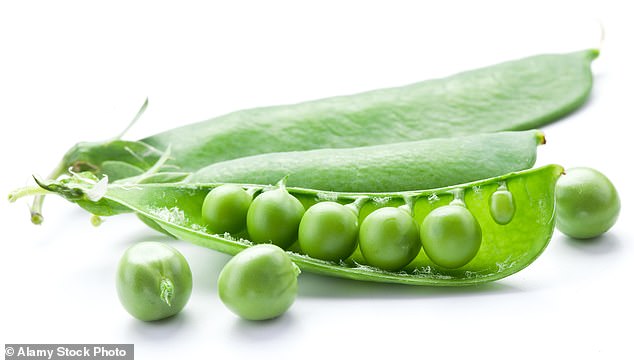
One of the most fibre-rich vegetables we have is green peas
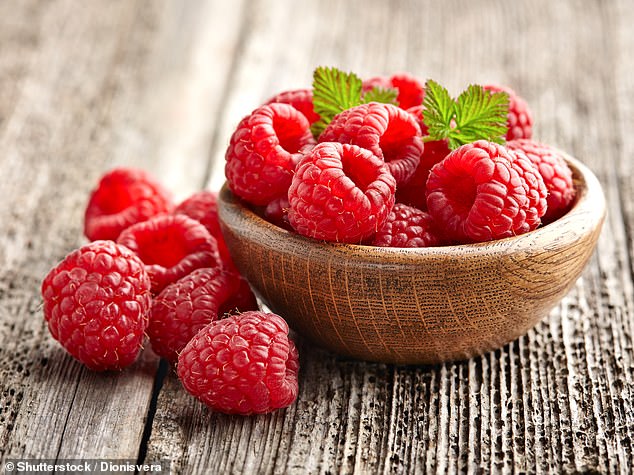
Raspberries and blueberries are packed with fibre, as are avocados, with just half of one providing 5g of it
In the colon, fibre becomes food for trillions of bacteria that make up our gut microbiome. These microbes break it down through fermentation, releasing a cascade of beneficial compounds that support the immune system, regulate hormones, reduce inflammation and even influence mood and brain health.
In short, fibre is the number one fuel for the gut microbiome – and the microbiome is emerging as the number one reason we stay well.
This vast ecosystem of gut bacteria not only helps digest food and eliminate toxins, but also produces powerful chemical signals that influence nearly every system in the body – from the brain to the bloodstream, even the reproductive organs.
The impact is measurable. Studies show that eating just 5g more fibre a day can reduce your risk of dying from any cause by 14 per cent. Hitting 25g of fibre a day, meanwhile – still less than the recommended amount – reduces the risk of heart disease-related death by 15 per cent. And research has also shown it has a similar effect on mental health.
A study run by the science and nutrition company that I co-founded, ZOE, on our wholefood supplement Daily 30+ – which has 5g of fibre in each scoop – found that nearly half of all participants who increased their fibre intake reported an improvement in mood.
We don’t know why fibre has this effect on the brain yet. But studies looking at the gut microbiomes of people with anxiety and depression have shown reduced diversity and an increased ratio of bad bacteria to good bacteria.
And then there are the weight-loss benefits – perhaps the most talked-about of all. My colleague, head nutritionist at ZOE Dr Federica Amati, puts it best. Fibre-rich foods, she explains, tend to be what nutritionists call high-volume, nutrient-dense and energy-poor – meaning they’re packed with essential vitamins and minerals, help keep you full, but contain fewer calories.
‘These are foods like leafy greens, cruciferous veg, peas, beans and mushrooms,’ Dr Amati tells me. ‘Even nuts and seeds – which people often worry about because of their high fat content – are less calorific than you think.
‘Because of their fibrous structure, the body only absorbs around 50 to 60 per cent of the calories per serving.’ But that’s not the only trick fibre plays. ‘High-fibre foods tend to be high volume,’ she explains. ‘They take up space in the stomach, forcing the gut to stretch slightly as they’re digested. That stretch sends a powerful signal to the brain: stop eating.
‘At the same time, when those foods reach the small intestine, amino acids absorbed from fibre-rich sources trigger more satiety signals, telling the brain you’re full. These are the same signals drugs like Ozempic mimic, just at a lower dose.
‘Essentially, when we eat a diet high in fibre, the body is doing the same thing as weight-loss jabs – all by itself.’
So just how does one ‘fibremaxx’?
Firstly, make sure when eating your 30g of fibre that you get it from as many different sources as possible. That’s why, at ZOE, we advise that people also aim to eat at least 30 different sorts of plants a week – to ensure enough diversity for the gut.
They don’t need to be fancy. In fact, one of the most fibre-rich vegetables we have is green peas. Raspberries and blueberries are packed with fibre, as are avocados, with just half of one providing 5g of it.
In terms of grains, unprocessed oats are brilliant, as are most wholewheat breads and any wholegrains like bulgur wheat.
And there are simple swaps as well that you can make even when eating out. Not many people know that pasta, for example, has four times as much fibre as rice.
My one warning is, make sure you build up your dose. If your body isn’t used to consuming a lot of fibre, your gut won’t be able to break it up effectively – which can cause gas and general digestive discomfort. And if you suffer from existing gastrointestinal issues such as irritable bowel syndrome (IBS), this may be a problem.
Give it small portions to get used to and trial different sorts of fibre to see what it can and can’t tolerate.
To inspire you further, here are some of my favourite recipes that are packed with fibre – and taste delicious.
Overnight Oats
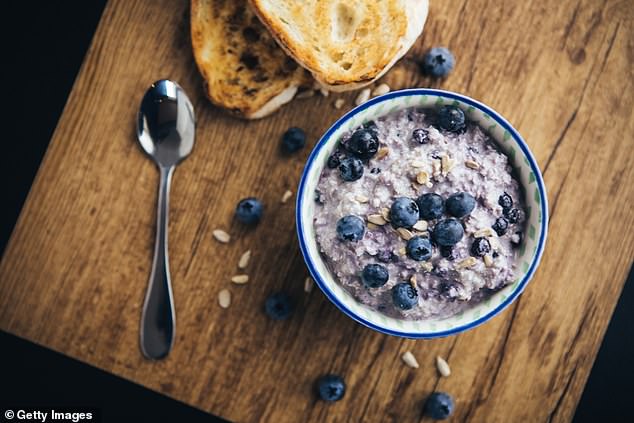
8g of fibre per serving
Ingredients
● 75g coarse porridge oats
● 15g dried cranberries
● 25g dried apricots, chopped
● 10g sultanas
● 150ml unsweetened apple juice
● 4 tbsp Greek yogurt
● 100g fresh or frozen blueberries
Method
1. In a large bowl, mix together the porridge oats, cranberries, apricots and sultanas. Add the apple juice and stir well. Cover and refrigerate overnight.
2. In the morning, share the soaked mixture between two cereal bowls.
3. Spoon one tablespoon of natural yogurt on to each portion, and share the berries between each of the bowls.
Roasted Aubergine Traybake
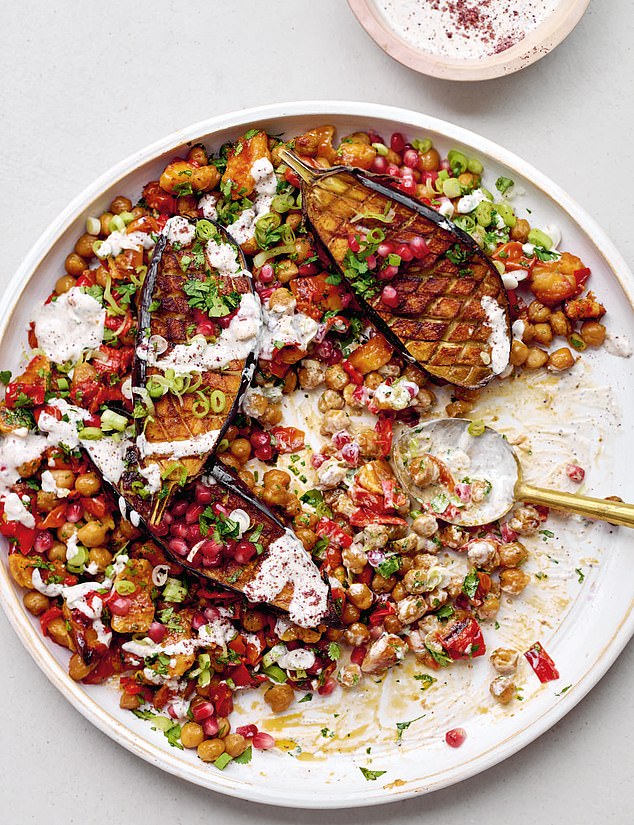
10-15g of fibre per serving
Ingredients
● 2 x 400g tins chickpeas, drained and patted dry
● 350g cherry tomatoes
● 2 peppers, cut into 2cm chunks
● 200g halloumi, cut into
1cm cubes
● 3 garlic cloves, unpeeled
● 2½ tsp ground cumin
● 1½ tsp ground coriander
● 1 tsp chilli powder
● 4 tbsp extra-virgin olive oil
● 2 aubergines, halved
● 3 tbsp tahini
● 180ml Greek yogurt or kefir
● 2 tsp sumac (spice)
● 20g coriander, roughly chopped
● 4 spring onions, thinly sliced
● 3 tbsp pomegranate seeds
● Juice of lime
● Salt and black pepper
Method
1. Preheat the oven to 200C/ 180C fan/gas 6 and line two baking trays with baking paper.
2. Put the chickpeas, tomatoes, peppers, halloumi and garlic cloves on one tray with three-quarters each of the cumin, coriander and chilli powder. Season and drizzle with 3 tbsp of the olive oil. Toss to coat.
3. Score the flesh of each aubergine half in a 2cm-deep criss-cross pattern. Sprinkle with the remaining spices and drizzle with the remaining oil, season and place on the baking tray. Place both trays in the oven for 40 minutes.
4. Mix the tahini, yogurt and sumac in a bowl and season. Squeeze the roasted garlic from their skins into the sauce, mash and combine.
5. Transfer the chickpea mixture to a dish and stir in three-quarters of the coriander. Place the aubergines on top and add the remaining coriander, the remaining ingredients and the sauce.
Creamy Green Pasta
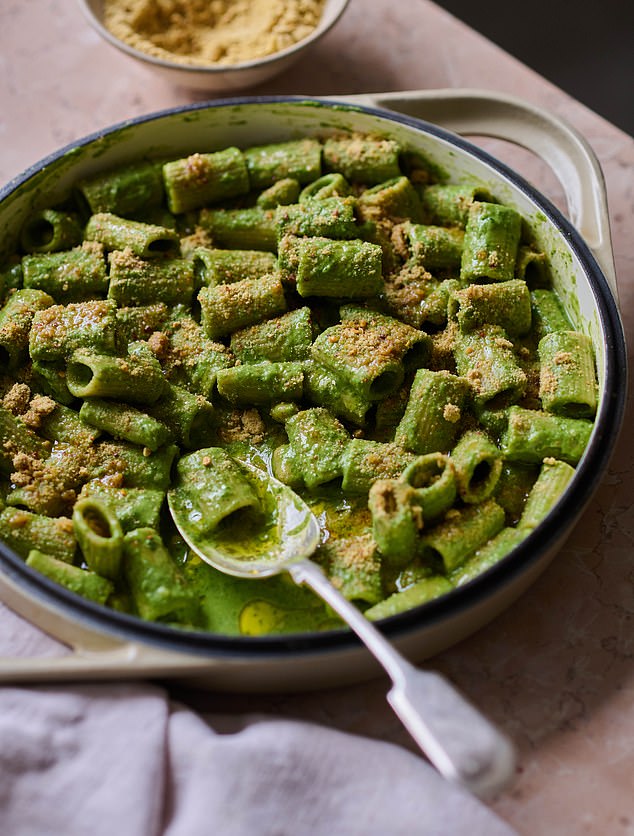
10-15g fibre per serving
Ingredients
● 90g wholewheat pasta
● 100g kale or spinach, thinly sliced
● 1 garlic clove
● Juice of 1 lemon
● 2 tbsp bouillon
● 1 x 400g tin cannellini beans and their liquid
● Salt and black pepper
Method
1. Bring two saucepans of salted water to the boil. Put
the pasta in one and cook for 8–10 minutes, or until
al dente.
2. Put the kale and garlic in the other saucepan and blanch for three minutes. When ready, drain and add to a blender with the lemon juice and bouillon.
3. Pour the beans into a sieve set over a bowl, keeping the liquid from the tin. Add a quarter of the beans to the blender along with the reserved liquid and blitz until totally smooth.
4. When the pasta is ready, drain, reserving 2 tbsp of the cooking water. Return the pasta to the pan with the remaining cannellini beans, reserved cooking water and the blended sauce. Heat through for a minute or so, taste and season, if necessary, and serve.
Pecan Chocolate Cookies
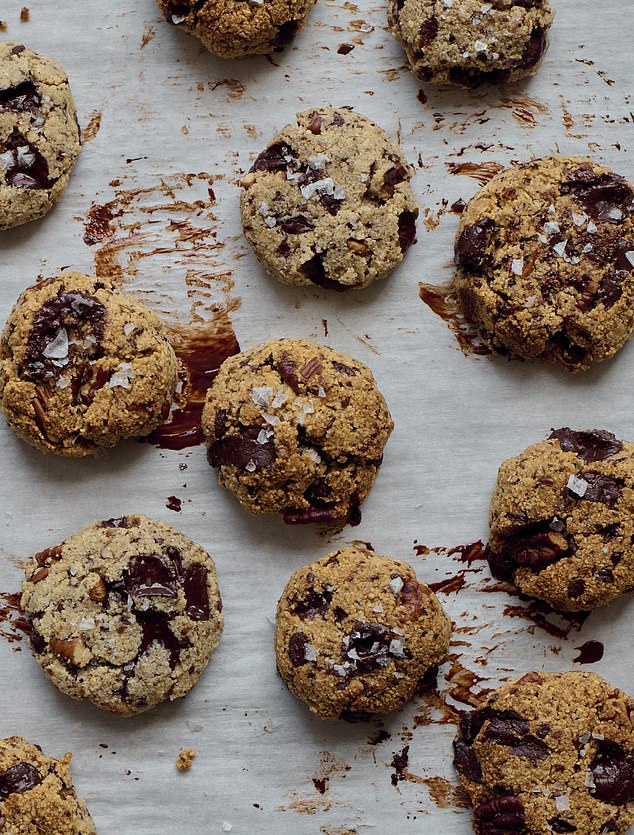
5g of fibre per serving
Ingredients
● 2 tbsp ground flaxseed
● 3 tbsp light brown sugar
● 4 tbsp extra-virgin olive oil
● 200g ground almonds
● 50g pecan nuts, roughly chopped
● 80g dark chocolate, roughly chopped
● Pinch of salt
Method
1. Preheat the oven to 180C/160C fan/gas 4 and line a baking tray with baking paper. Mix the ground flaxseed with 4 tbsp of water and set aside for 15 minutes.
2. Mix the brown sugar, olive oil and flax mixture together. Add the ground almonds, pecan nuts, chocolate and salt and mix again.
3. Shape into 12 tight balls and flatten slightly into cookies about 1cm thick (it helps if you do this with damp hands). Bake for 10–12 minutes until tinged golden brown at the edges, then leave to cool completely on the tray. Store in an airtight container.












